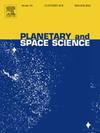Maximizing the velocity deflection of asteroid Didymos using the Whale Optimization Algorithm
IF 1.7
4区 物理与天体物理
Q3 ASTRONOMY & ASTROPHYSICS
引用次数: 0
Abstract
This study aims to optimize the velocity change of the Didymos asteroid using the Whale Optimization Algorithm (WOA). The deflection of asteroids that pose significant threats to Earth is a crucial aspect of upcoming space missions. In this research, a spacecraft is attached to the Didymos asteroid, utilizing its gravitational force as a perturbation to modify the asteroid's trajectory. The transfer of kinetic energy from the spacecraft to the asteroid induces a change in velocity (ΔV). The findings indicate that the most substantial impact on velocity occurs in the radial direction, showing divergent oscillatory behavior. The results suggest that the optimal point for significant velocity change is located shortly after the perihelion. At this point, WOA achieves the maximum velocity change. Additionally, the stability of the asteroid's deflection is investigated due to the nonlinear characteristics of the orbital motion equations. The optimal velocity change is identified as at , occurring after the perihelion at . This study introduces a novel optimization approach for asteroid deflection, emphasizing the nonlinear dynamics of orbital motion.
利用鲸鱼优化算法最大化小行星Didymos的速度偏转
本研究旨在利用鲸鱼优化算法(Whale Optimization Algorithm, WOA)对Didymos小行星的速度变化进行优化。对地球构成重大威胁的小行星的偏转是即将到来的太空任务的一个关键方面。在这项研究中,一艘宇宙飞船附着在Didymos小行星上,利用它的引力作为扰动来改变小行星的轨迹。动能从航天器转移到小行星引起了速度的变化(ΔV)。结果表明,对速度影响最大的是径向,表现为发散振荡行为。结果表明,速度显著变化的最佳点位于近日点后不久。此时,WOA达到最大速度变化。此外,由于轨道运动方程的非线性特性,研究了小行星偏转的稳定性。最佳速度变化为ΔVtotal=2.5139×10−7(km), Δt=27.657(h),发生在近日点t(h)ΔVmax之后。本文提出了一种新的小行星偏转优化方法,强调了轨道运动的非线性动力学。
本文章由计算机程序翻译,如有差异,请以英文原文为准。
求助全文
约1分钟内获得全文
求助全文
来源期刊

Planetary and Space Science
地学天文-天文与天体物理
CiteScore
5.40
自引率
4.20%
发文量
126
审稿时长
15 weeks
期刊介绍:
Planetary and Space Science publishes original articles as well as short communications (letters). Ground-based and space-borne instrumentation and laboratory simulation of solar system processes are included. The following fields of planetary and solar system research are covered:
• Celestial mechanics, including dynamical evolution of the solar system, gravitational captures and resonances, relativistic effects, tracking and dynamics
• Cosmochemistry and origin, including all aspects of the formation and initial physical and chemical evolution of the solar system
• Terrestrial planets and satellites, including the physics of the interiors, geology and morphology of the surfaces, tectonics, mineralogy and dating
• Outer planets and satellites, including formation and evolution, remote sensing at all wavelengths and in situ measurements
• Planetary atmospheres, including formation and evolution, circulation and meteorology, boundary layers, remote sensing and laboratory simulation
• Planetary magnetospheres and ionospheres, including origin of magnetic fields, magnetospheric plasma and radiation belts, and their interaction with the sun, the solar wind and satellites
• Small bodies, dust and rings, including asteroids, comets and zodiacal light and their interaction with the solar radiation and the solar wind
• Exobiology, including origin of life, detection of planetary ecosystems and pre-biological phenomena in the solar system and laboratory simulations
• Extrasolar systems, including the detection and/or the detectability of exoplanets and planetary systems, their formation and evolution, the physical and chemical properties of the exoplanets
• History of planetary and space research
 求助内容:
求助内容: 应助结果提醒方式:
应助结果提醒方式:


